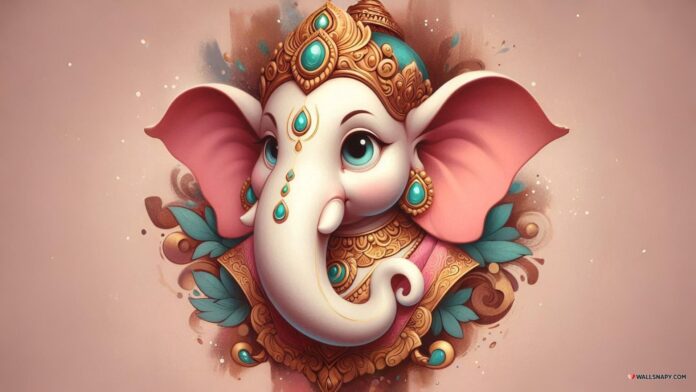Lord Ganesha, instantly recognisable by his elephant head and pot-bellied human body, is one of the most beloved and worshipped deities in the Hindu pantheon. He is the god of beginnings, wisdom, and intellect, the patron of arts and sciences, and the deva of intellect and wisdom. More than just a religious icon, Ganesha is a profound cultural symbol, embodying a unique blend of profound philosophical concepts and approachable, childlike charm.
This article provides a detailed look at his mythology, symbolism, worship, and enduring global appeal.
1. The Origin Stories: Birth and the Elephant Head
The birth of Ganesha is described in various Purana, with slight variations. The most famous narrative comes from the Shiva Purana.
The Story of His Creation:
Goddess Parvati, the consort of Lord Shiva, desired a son and created a boy from the turmeric paste she used for her bath. She breathed life into him and appointed him as her guard, instructing him to allow no one to enter while she bathed.
Lord Shiva returned from a long period of meditation and was stopped at the door by this young boy who, loyal to his mother’s orders, refused him entry. Unaware that this was his son, Shiva’s rage flared. A fierce battle ensued between Shiva’s attendants (Ganas) and the boy, who held his ground valiantly.
Finally, an enraged Shiva severed the boy’s head with his trident. When Parvati emerged and witnessed the scene, she was overcome with grief and fury. To pacify her, Shiva sent his followers to fetch the head of the first living being they encountered, which was an elephant. Shiva placed the elephant’s head on the boy’s body and revived him. He declared the boy to be his own son, named him Ganesha (Lord of the Ganas), and bestowed upon him the blessing that no undertaking would be successful without invoking his name first.
2. The Profound Symbolism of His Form
Every aspect of Ganesha’s iconography is rich with symbolic meaning:
-
Elephant Head: Represents wisdom, intelligence, and a discriminating intellect (buddhi)—the ability to perceive and distinguish between reality and illusion. The large head signifies thinking big.
-
Large Ears: Denote the importance of listening more and speaking less. They signify the ability to absorb knowledge and discern truth from gossip.
-
Small Eyes: Symbolise deep concentration and the ability to see beyond the obvious, perceiving the subtle truths of the universe.
-
Trunk: A multi-purpose tool, symbolising high efficiency and adaptability. It can lift a heavy log or pick up a tiny pin, representing the ability to handle both the gross and subtle aspects of life.
-
Pot Belly (Lambodhara): Signifies the ability to digest all of life’s experiences—both good and bad—with equanimity and to contain the entire universe within.
-
One Tusk: Ganesha is often depicted with a broken tusk. Mythology states he broke it off to use as a pen to write the epic Mahabharata, dictated by the sage Vyasa. It symbolises sacrifice for a higher cause and the idea of retaining the good and discarding the bad.
-
Four Arms: Represent the four inner attributes of the subtle body: mind (mamas), intellect (buddhi), ego (ahamkara), and conditioned conscience (chitta).
-
Axe/Rope: In two of his hands, he holds an axe (to cut off attachments) and a rope (to pull the devotee closer to the supreme truth or to tether desires).
-
Modak (Sweet Dumpling): His favourite sweet, symbolising the rewards of a spiritual journey—the sweetness of the realised soul.
-
Abhaya Mudra (Gesture of Protection): His hand in a blessing gesture assures protection and fearlessness for his devotees.
-
-
Mouse as His Vehicle (Vahana): The mouse, often seen at his feet, symbolises the ego and desires, which are restless and can gnaw at our virtues. Ganesha, as the master, rides the mouse, representing perfect control over ego and desires. It also symbolizes Ganesha’s ability to penetrate even the smallest, most hidden places to remove obstacles.
3. Titles and Their Meanings
Ganesha is known by 108 names, each reflecting an attribute or a story:
-
Vighnaharta: The Remover of Obstacles.
-
Ganapati: Lord of the Ganas (Shiva’s attendants).
-
Vinayaka: The Supreme Leader.
-
Ekadanta: The One-Tusked.
-
Lambodara: The One with a Pot Belly.
-
Siddhidata: The Giver of Success.
4. Worship and Festivals
-
Beginning of Endeavors: Hindus invoke Ganesha’s name at the start of any new venture—be it a business, a journey, a new home, or even writing a book—to ensure success and remove hurdles.
-
Ganesh Chaturthi: The most important festival dedicated to him. It involves the installation of clay idols in homes and public pavilions, followed by days of worship, chanting, and community events. The festival culminates in the immersion (Visarjan) of the idols in a water body, symbolising the cycle of creation and dissolution.
-
Daily Prayers: Many begin their day with a prayer to Ganesha. The lord ganesha Atharvashirsha is a key devotional text recited in his honor.
5. Philosophical Significance
Beyond the stories, Ganesha represents the ultimate reality (Brahman) in Hindu philosophy. He is the first sound “AUM” or “OM,” from which all creation emanates. He is the embodiment of the perfect balance between:
-
Power and Compassion: As the son of Shiva (the destroyer) and Parvati (the nourisher).
-
Human and Animal: Representing the connection between the earthly and the divine.
-
Wisdom and Childlike Innocence.
6. Global Presence and Modern Relevance
Ganesha’s appeal has transcended Hinduism. He is seen as a universal symbol of:
-
Overcoming Challenges: His role as “Remover of Obstacles” resonates with people of all backgrounds facing difficulties.
-
Wisdom and Success: He is a patron for students, artists, and business people alike.
-
Inclusivity: His unique form celebrates the idea that divinity is not confined to a perfect human image.
His image is found in yoga studios, on dashboards of cars as a talisman for safe travel, and in the homes of people worldwide who are drawn to his benevolent and wise energy.
Conclusion: The Enduring Legacy of the Elephant God
Lord Ganesha is much more than a mythological figure. He is a deeply philosophical concept, a cultural touchstone, and a personal source of comfort and inspiration for millions. He teaches that true wisdom lies in using one’s intellect to overcome desires and obstacles, that one should approach life’s journey with a sense of joy (symbolised by the modak), and that no endeavor can truly succeed without first invoking the qualities of discernment, adaptability, and peaceful strength that he so perfectly embodies. He is, in every sense, the Lord of Beginnings and the Guardian of Thresholds, guiding humanity from ignorance to enlightenment.



